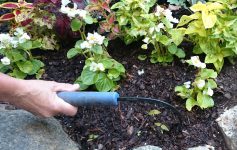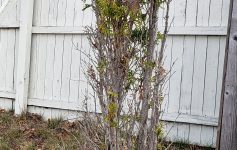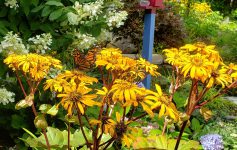 Hands down my favorite plant in the landscape is that of the Hydrangea. This old fashion plant takes me back to my Grandmother’s garden growing up. She had the most beautiful blue hydrangeas nearby her porch. Coming in the driveway as a kid I remember these huge blue ball like flowers greeting me. Today hydrangeas are enjoying new found popularity with the multitude of varieties on the market. Their flowers offer great garden interest throughout the summer. In the Fall as their colors change you can cut and dry them for indoor arrangements or leave them in the landscape for an interesting snow capped visual. This past weekend I had the opportunity to use large white hydrangea in a bride’s bouquet. It versatility is endless.
Hands down my favorite plant in the landscape is that of the Hydrangea. This old fashion plant takes me back to my Grandmother’s garden growing up. She had the most beautiful blue hydrangeas nearby her porch. Coming in the driveway as a kid I remember these huge blue ball like flowers greeting me. Today hydrangeas are enjoying new found popularity with the multitude of varieties on the market. Their flowers offer great garden interest throughout the summer. In the Fall as their colors change you can cut and dry them for indoor arrangements or leave them in the landscape for an interesting snow capped visual. This past weekend I had the opportunity to use large white hydrangea in a bride’s bouquet. It versatility is endless.
But hydrangea questions often fall at the top of my customer’s list regarding use and care, Why aren’t they blooming, Why do they change color? How do I care for them? As they are now emerging or in full bloom in our gardens here (depending on your type of hydrangea) I thought now a good time to give hydrangeas some blog attention.
I just love the variety of flower styles hydrangeas offer. The mophead (Macrophylla) is the most well-known flower style. This is a large, rounded cluster made up of hundreds of florets. The Endless Summer variety is now incredibly popular in gardens. This variety tends to do well in our region and produces reliable blooms. Unlike the old Nikko Blue variety you routinely see available for purchase in many retail outlets around the Easter and Mother’s Day holidays. The lace-cap variety offer a more delicate option. They produce flat flower clusters with a ring of larger flowers surrounding a center of smaller florets. Panicle hydrangeas that include our native varieties of quercifolias (oakleafs) and paniculatas have large white cone shape flower clusters. These start out white and fade to various shades of pink as they mature. Newer varieties such as limelight, quickfire and strawberry vanilla offer more contrast in their colors.
Except for the white varieties, the flower color of the mop head varieties can change color. But I will devote my next blog to a full dialog on this as it takes a bit more explaining and guidance in care.
Hydrangea LOVE water! Keeping your plants well watered and mulched will produce a healthier plant. Mulching not only protects the roots but good organic mulch provides great nutrition in the decomposition process. So keeping them in a moist fertile soil that will not dry out will help them perform. Afternoon shade helps minimize wilting and preserve and extend blooms.
Hydrangeas are heavy feeders. That is why a good organic mulch is important for the season. Slow release fertilizers allow them to feed slowly over time. Extra nutrients can be applied early in the season before leaf out, making available food when the plant most needs it. Stay away from late summer fertilization. Once leaves had dropped in fall…apply a good root support fertilizer.
Pruning is the biggest mistake made with hydrangeas. I leave the old flowers on throughout the winter to protect new growth tips. In the spring I just cut back the heads if the shrub is not overgrown. You can also distinguish dead canes from viable canes then. If your plant is overgrown…do a major prune (up to 1/3) if the plant is over 4 years old. Most varieties grow on old wood…so you dont want to wait too late in the season to prune as you will cut off this year’s bloom tips. The Endless Summer variety touts their ability to grow on old and new wood…but I am still skeptical of this in our region..finding late pruning in general reduces blooms
A real bonus on hydrangea is it’s lack of common pests and diseases. They can live a good 50 plus years on properties and produce well. Occasionally you may see some spider mites colonizing during dry spells or slugs and powdery mildew attacking leaves during high humidity, but this is merely cosmetic in nature. Not a threat to the plant. It can be managed with topical sprays. Check with your local nursery to help you out with this.
Next week I will blog on how to change hydrangea flow colors.



